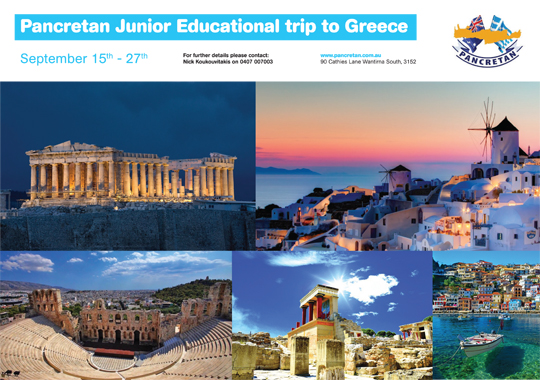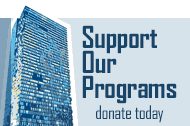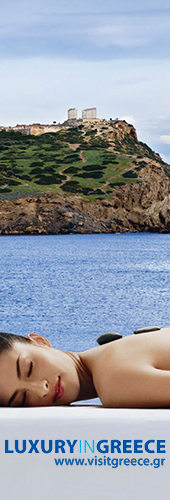|
 The Pancretan Association of Melbourne is planning a junior educational trip to Greece and to Crete in September. According to the program of the trip, the group wil departure from Melbourne on 15 September 2019 and will return at the end of the month. The Pancretan Association of Melbourne is planning a junior educational trip to Greece and to Crete in September. According to the program of the trip, the group wil departure from Melbourne on 15 September 2019 and will return at the end of the month.
For further details please contact Nick Koukouvitakis on 0407 007003 or visit the website pancretan.com.au.
The program of the Pancretan Junior Edcational Trip to Greece:
15 September – Flight to GreeceDeparture from Melbourne.
16 September – Athens
We will arrive in Athens. Our bus will transfer us to our hotel for check in. Today afternoon is free. We will have dinner at the hotel and overnight.
17 September – Athens city tour
We will enjoy breakfast at the hotel and be ready to meet our guide at 09.00am at the hotel's reception for a full day sightseeing of Athens.
We will visit the world-famous Acropolis,marble-capped with the Parthenon, the Tomb of the Unknown soldier, the Parliament House, the Presidential Palace, the Panathenian Stadium, the Temple of Olympian Zeus, the Academy, the University and the National Library, In the afternoon, we will visit the new Acropolis Museum and the Ancient Agora of Athens. We will return to the hotel around 5.30pm, have dinner and stay overnight.
18 September – Delphi day tour
After breakfast we depart from Athens in the morning via the national highway and pass by the towns of Thebes, Levadia and Arachova.
Arriving in Delphi we’ll visit Castalia Spring and the main archaeological site (the Temple of Apollo, the Treasury of the Athenians, the Theatre, the Stadium,etc.) and the Museum with the famous statue of Antinoos and the unique bronze statue of the Charioteer dated from 475 B.C.
During the Mycenaean period, the female deity of Earth was worshipped in the small settlement of Delphi. The development of the sanctuary and oracle though, began in the 8th century B.C. with the establishment of the cult of Apollo. Under the protection and administration of the
Amphictyony, the sanctuary continued to be autonomous after the First Sacred War and, as a result, increased its pan Hellenic religious and political influence. The Pythian Games were re-organized, the sanctuary was enlarged, and it was enriched with nice buildings, statues, and other offerings. In the 3rd century B.C. it came under the domination of the Aetolians and later, in 191 B.C., was conquered by the Romans.
During the Roman occupation the site was sometimes plundered but was also favored by some of the emperors. With the spread of Christianity, the sanctuary lost its religious meaning and was permanently closed down with a decree of emperor Theodosius the Great.
The ruins of Delphi were uncovered by the systematic excavations of the French Archaeological School, which began in 1893. The village of Kastri, which had occupied the area of the sanctuary since medieval times, was moved to its present position. After the removal of huge quantities of earth that had been accumulated with the landslides, the remains of two sanctuaries, dedicated to Apollo and Athena Pronaea, were finally uncovered. The excavations revealed more than five thousands inscriptions of all kinds, statues, several miniature objects, architectural decorative pieces, all exquisite works of art, representing the major cities of Greek antiquity. We will return to the hotel for dinner and overnight.
19 September – 3 island day trip
This morning we will be transferred to the port of Piraeus to embark on our small cruise ship for our 3 island day cruise From the very beginning of the cruise the live orchestra and entertainers will put us in the right mood with their Greek & international music repertoire.
First port of call is Poros. Poros is the smallest of the three islands, separated from the Peloponnese by a narrow strait and offering a most enchanting view of Poros Town. Your time at leisure in Poros will be about 50 minutes. The journey continues and as we sail towards the Island of Hydra lunch is served giving you an opportunity to enjoy a rich choice of Greek specialties accompanied with a cheerful repertoire of Greek and International music. As we enter the port of Hydra you will be able to admire the unique architecture and dramatic landscapes of this island, whose small narrow stone-paved streets waiting to be explored on foot or by the island’s traditional “vehicle”s – the addled donkey. The journey continues and as we sail towards Aegina Island. Upon arrival you will have time to relax & enjoy this beautiful island.
Finally as we sail towards Piraeus you can enjoy of “Traditional Greek Folk Show” with singers and dancers in original costumes from all of Greece who, together with our officers, Hostesses and the ever amusing entertainer Jeannot will entertain and animate you up to the final moments as the ship docs in the port. We will have dinner at the hotel.
20 September – Heraklion
After breakfast we will be transferred to Athens International airport for our flight to Heraklion. After our arrival in Heraklion and transfer to the hotel the day is free for exploration.
21 September – Knossos Palace & Museum
Crete is the largest and the most rugged of the Greek islands. It is also the home of the great Minoan Civilization and the mythological home of Zeus. After a short drive through the town of Heraklion the tour will arrive at the Knossos excavations. Here, Sir Arthur Evan’s archaeological discoveries revealed a civilization dating back to 4000 B.C., when a great empire flourished on the island of Crete. Based on the wealth of artefacts that were found, Evans theorized that this was the site of the ancient Minoan Kingdom. These findings will be viewed in detail, as your guide will lead you on a journey of discovery to learn of the sophisticated culture that flourished thousands of years ago on this island. The Palace, decorated with frescoes and shields houses the Hall of the Royal Guard, the Hall of the Double Axes, the King's Chamber with the alabaster throne, the Queen's Apartment, beautiful courtyards and shrines. Having visited this remarkable site our coach
will take us to the heart of Heraklion where we will visit the Archaeological museum and enjoy a walking tour to explore its beauties combining the facilities of a modern city with the unique Greek islands’ ambience. Dinner and overnight at the hotel.
22 September – Agios Nikolaos / Spinaloga
This morning we drive to Agios Nikolaos for a day excursion to this beautiful town and to Spinaloga island. An excursion to Spinalonga Island is always a remarkable experience. A place linked with Crete's modern history, offers timeless feelings to the locals even these days. Starting early in the morning, we will arrive firstly at Agios Nikolaos, having a walking tour for exploring the city, which has been developed around its famous lake "Voulismeni". After the walking tour in the capital of Lassithi area, our journey continues northern, towards the small village of
Plaka, where we will get on board for our short trip to Spinalonga. Life has paused in this island, since the leper colony came to an end in 1957. However, the small houses, the service buildings and the alleys are still remaining, only attached by the time. You will have the opportunity to discover the island by yourselves, in every path of it. Then, we will return to Agios Nikolaos where we will have time for lunch and (weather permitting) swimming. Late in the afternoon we will return to Heraklion and our hotel for dinner and overnight.
23 September – Rethymno
This morning we drive to Rethymno. After a short walking tour of the city we drive to the monastery of Arkadi. The monastery of Arkadi is built on a low rocky plateau, 23 kilometers south east of the town of Rethymnon. Burned in 1866 by the Turks, it has become the islands's most famous monastery, standing as a memorial to the fight for freedom from the Turkish occupation. Built towards the end of the Venetian period, its numerous buildings give the impression of a fortress like structure, where people could find refuge in troubled time of the past.
You will be guided through the main buildings where the cells, stables and the warehouses where agricultural products were treated andstored, are housed. The excursion continues to ancient Eleftherna, built on two long narrow ridges called Pyrgi and Nissi. Excavations begun in 1929 by the British Archaeological School and were followed by a more systematic work carried out by the department of Archaeology and Art History of the University of Crete in 1985. Unearthed ruins of Hellenistic walls, Roman buildings, an Early Christian Basilica and burial grounds can be seen. We will have the opportunity to visit the site on a guided tour before you return to Rethymnon for our dinner.
24 September – Chania
We will drive to the Monastery of Chrysopigi, founded by the family of Chartophylakas in the 16th century. The original section is in the center of the church. The Turks entered the Monastery on Easter Day of 1821 and murdered all the monks. Today, it is a convent with several nuns still living in residence. We continue our tour to the Archeological Museum of Chania that is housed in the Catholicon of the Venetian Monastery of St. Francis. During the period of the Turkish occupation, it was the Muslim Mosque of Yussuf Pasha. While in recent periods, it was used as a cinema or a storehouse for military equipment. Since 1963, it has been functioning as the Archeological museum of the city.
The collection of the museum includes , Minoan finds from the city of Chania, prehistoric finds from caves, coins jewelry , sculpture, inscriptions stelae Mosaics and finds of graves of the Geometric period. Afterwards we will walk with our guide in the wonderful town of Chania. After some free time return back to your hotel in Chania for dinner and overnight.
25 September – Chania tour
Today we will have a tour to Chania town and Ancient Kydonia. The modern city of Chania is founded in the site of a significant ancient Minoan settlement, Kydonia or ku-do-ni-ja as it appears on Linear B script. According to the tradition, Kydonia was one of the three cities founded by King Minos in Crete. The settlement that is presently excavated in the city of Chania has as center the hill of Kasteli and is the most important of the prefecture. Large habitations with well-built rooms, elegant floors with circular cavities- fireplaces, coated walls with deep red mortar, door frames and ceramics of excellent quality are some of the findings that indicate the existence of a significant proto-Minoan centre. The extended excavations in the archaeological site of Kasteli, which constitutes one of the most important monuments
of the prehistoric period of Crete, are carried out since 1966 until today by the 25th Ephorate of Prehistoric and Classical Antiquities. Some of the most important findings of the excavation are available in Chania Archaeological Museum. Return to the hotel for dinner and overnight.
26 September - Elafonissi tour
This morning we will have a full day trip to Elafonissi beach. A trip to this famous lagoon with its crystal-clear water and pink coral sands is unforgettable. Located on the far south west tip of Crete the drive will takes us inland via the spectacular Topolia Gorge. The first stop enroute to the beach is the St Irini (Agia Irini) cave – there are about 240 steps up to the cave with stalagmites, stalactites and the small chapel. A few kilometres further on we will arrive at Elafonissi beach. We are free to rent a sun bed or wade across to the island. In peak season it can be a very busy place. There are canteens for soft drinks & snacks. On the return journey we stop at the lovely shady village of Elos, home of the chestnut festival in October. Here we can have a snack or coffee or ice cream at one of the tavernas of the village. Late afternoon return to our hotel in Chania for our farewell dinner.
27 September – Departure
We fly back home full of wonderful memories of our trip to Greece. |



 The Pancretan Association of Melbourne is planning a junior educational trip to Greece and to Crete in September. According to the program of the trip, the group wil departure from Melbourne on 15 September 2019 and will return at the end of the month.
The Pancretan Association of Melbourne is planning a junior educational trip to Greece and to Crete in September. According to the program of the trip, the group wil departure from Melbourne on 15 September 2019 and will return at the end of the month.





